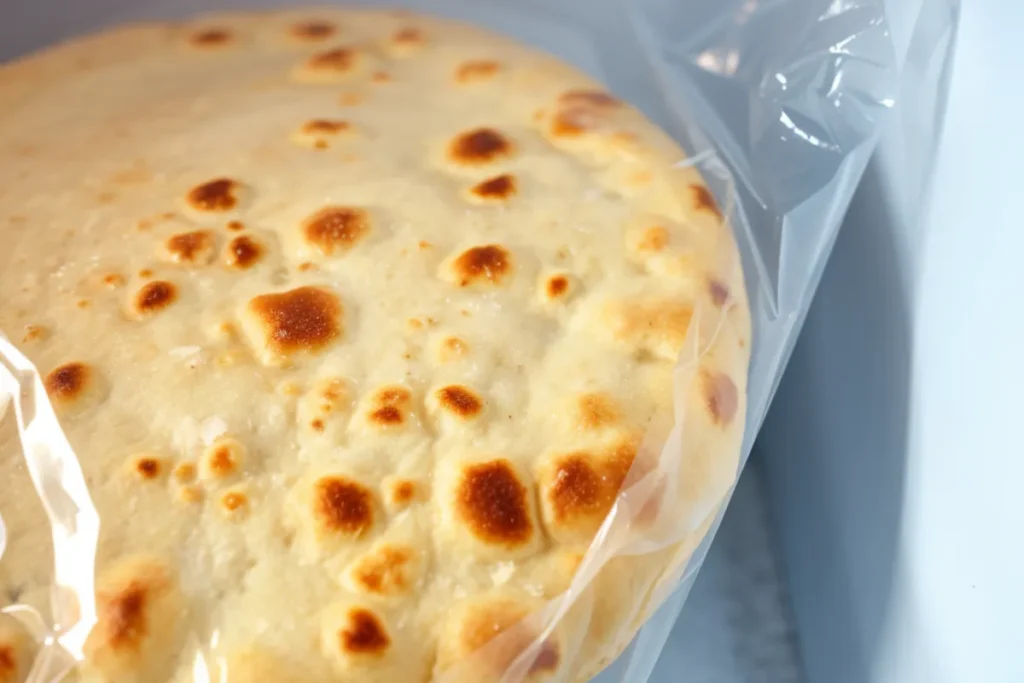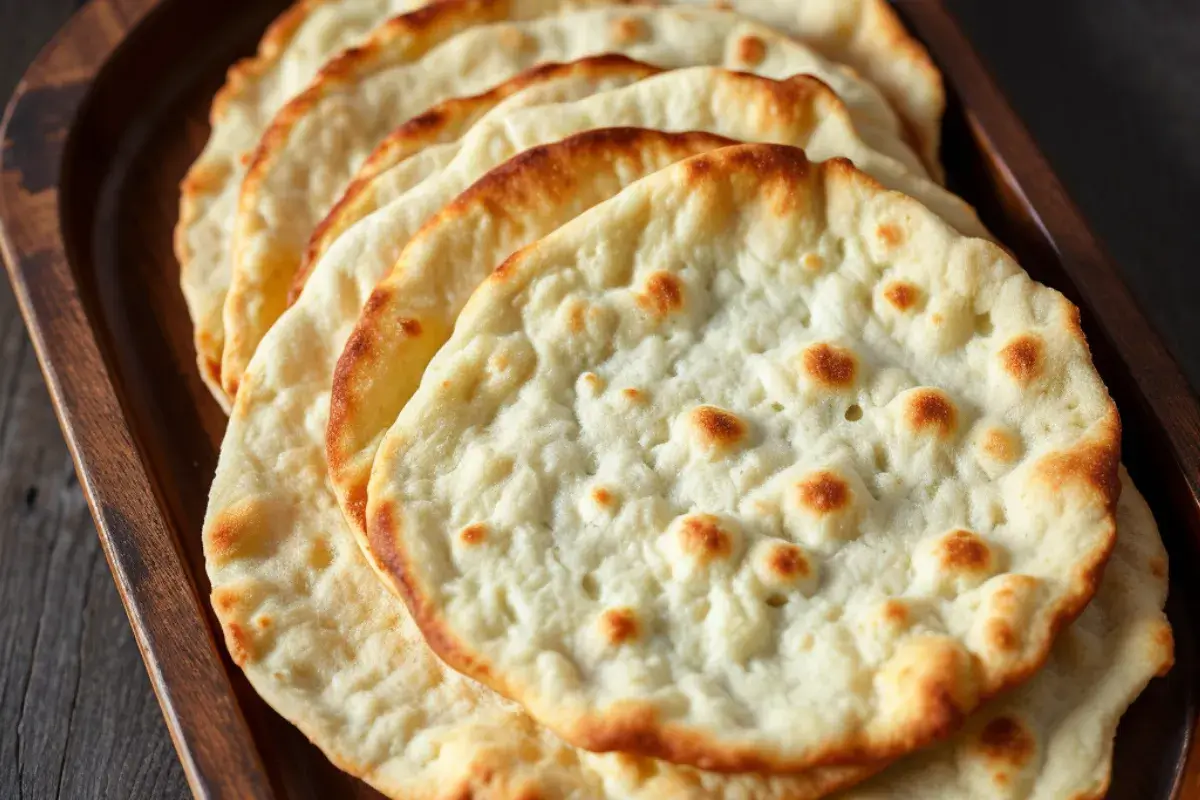Cottage cheese flatbread is a tasty and healthy bread alternative. It’s rich in protein and low in carbohydrates, making it perfect for those on gluten-free or low-carb diets. Whether you use it for wraps, sandwiches, or pizza, proper storage is essential to keep it fresh and flavorful. This guide will help you store your cottage cheese flatbread so that it stays as delicious as when you first made it.
What Is Cottage Cheese Flatbread?
Cottage cheese flatbread is simple to make, but knowing how to store cottage cheese flatbread properly is just as important to keep it fresh. This combination creates a soft and protein-packed flatbread that’s a popular choice for those who want a healthier option. Learn more about how cottage cheese can be a healthy substitute in various recipes, including baking, in this article.
For a step-by-step guide on how to make this flatbread from scratch, check out this easy cottage cheese flatbread recipe.
This flatbread is also versatile. You can use it for different meals throughout the day—whether as a sandwich, a wrap, or even a pizza base. To learn more about the benefits of adding cottage cheese to your meals, check out this guide on cottage cheese benefits.
Why Proper Storage Is Important
It’s essential to store cottage cheese flatbread correctly to maintain its freshness and flavor. Without the right storage, it can quickly lose its texture, become soggy, or even spoil. Cottage cheese and eggs add moisture, which is why it’s more prone to changes in texture. Proper storage can also help you save time by allowing you to make flatbread in bulk and enjoy it over several days.
Storing Cottage Cheese Flatbread at Room Temperature
If you plan to eat your flatbread within a day or two, storing it at room temperature is fine. However, because it contains dairy and eggs, some precautions are needed.
- Use an airtight container: Keeping the flatbread in an airtight container helps prevent it from drying out.
- Add parchment paper: If you’re stacking the flatbread, use parchment paper between each layer to avoid sticking.
- Limit storage to two days: Cottage cheese and eggs can spoil quickly. After two days at room temperature, it’s best to move it to the fridge.
Pro Tip:
Avoid adding toppings like tomatoes or sauces before storing the flatbread. Moist toppings can make it soggy. Instead, add these just before eating. Discover additional tips to prevent your flatbread from becoming soggy here.
How to Store Cottage Cheese Flatbread in the Refrigerator
Refrigerating cottage cheese flatbread allows you to store it for longer—up to four days. However, refrigeration can sometimes affect the texture, making it a bit firmer. To store it properly:
- Cool it completely: Let the flatbread cool before placing it in the fridge. Wrapping it while still warm can trap moisture and make it soggy.
- Wrap tightly: Use plastic wrap or place the flatbread in an airtight container.
- Separate with parchment paper: This prevents the pieces from sticking together.
Reheating from the fridge:
To keep the texture intact, reheat the flatbread in a toaster or oven. This helps restore its original crispiness. Avoid microwaving, as this tends to make the flatbread too soft.
Freezing Cottage Cheese Flatbread

If you’ve made a large batch, freezing is a good option. Cottage cheese flatbread can last for up to one month in the freezer. However, freezing can slightly change the texture, so it’s important to freeze it correctly:
- Cool the flatbread: Let it cool completely before freezing.
- Wrap each piece individually: Use plastic wrap or foil to wrap each portion separately. This prevents them from sticking together in the freezer.
- Place in a freezer-safe bag: Once wrapped, place the flatbread in a freezer-safe bag, and remove as much air as possible.
Freezing Tip:
It’s best not to freeze flatbread with toppings. Wet ingredients like tomatoes or sauces can become watery and affect the bread when thawed.
Thawing and Reheating Frozen Flatbread
To thaw the flatbread, place it in the fridge overnight. Once thawed, reheat it in the oven or toaster for the best texture. This will help restore the crispness that may be lost in freezing. Avoid microwaving frozen flatbread, as it may become soggy.
Why Proper Storage Saves Time and Effort
Properly storing your cottage cheese flatbread not only keeps it fresh but also saves you time. By making a larger batch and storing it correctly, you’ll always have a quick and healthy meal option on hand. Whether you’re keeping it at room temperature for a short time or freezing it for future use, following these storage tips will make your flatbread last longer and taste better.
By following these steps, you’ll ensure your cottage cheese flatbread stays fresh, whether you’re storing it for a day or a few weeks. Proper storage techniques are simple but essential to preserving the texture and flavor of this versatile flatbread.
Best Methods for Reheating Cottage Cheese Flatbread
Reheating is key to maintaining the crispy yet soft texture of your flatbread. Each method comes with its own benefits, depending on the time you have and the texture you want.
- Oven: If you want the best results, preheat your oven to 350°F (175°C). Place the flatbread on a baking sheet and bake for about 5-8 minutes. The oven brings back the crispy texture, much like when it was first made. In addition, it helps heat the flatbread evenly without making it soggy.
- Toaster: For a quicker option, the toaster works well. Toast your flatbread for 1-2 minutes, but keep a close eye on it to avoid burning. This method adds a light crunch to the bread.
- Air Fryer: Another excellent way to reheat is the air fryer. Set it to 350°F (175°C) and heat the flatbread for 3-5 minutes. The air fryer delivers a crispy texture quickly, making it a great choice when you’re short on time.
Microwave: A Last Resort
While the microwave is convenient, it tends to make flatbread soggy due to the moisture content. If you must use it, wrap the flatbread in a paper towel and heat it on low for no more than 30 seconds. The paper towel will absorb some moisture, but this method should only be used when necessary.
How to Keep Flatbread Fresh After Reheating
Once the flatbread is reheated, keeping it fresh is essential to maintain its delicious texture. First of all, make sure you serve it immediately after reheating for the best results. If you need to keep it warm for a bit, avoid wrapping it tightly in foil, as this can trap steam and make it soft again. Instead, cover it loosely to maintain some crispness.
- Top just before eating: For the best flavor and texture, add moist toppings like avocado, tomato, or hummus after reheating. This way, the flatbread doesn’t absorb extra moisture, which would make it soggy.
- Let it cool slightly: After reheating, let the flatbread cool for a few minutes before eating or storing it again. This prevents excess moisture from forming, which can soften the bread.
Enhancing the Shelf Life of Cottage Cheese Flatbread
Proper storage can greatly extend the shelf life of your cottage cheese flatbread. For example, using the right ingredients and storing methods can add a few extra days to its freshness.
- Use natural preservatives: Adding ingredients like garlic and herbs not only improves flavor but also helps slow down spoilage. Garlic and herbs such as oregano or basil have natural antibacterial properties that can help extend shelf life.
- Reduce moisture in the batter: Another way to extend the life of your flatbread is by slightly reducing the moisture in the batter. For instance, using thicker cottage cheese or adding a bit more seasoning can lower the overall moisture, which helps keep the flatbread fresher for longer.
Signs That Cottage Cheese Flatbread Has Gone Bad
It’s essential to recognize when your flatbread is no longer safe to eat. Paying attention to visual and sensory cues will help you avoid consuming spoiled food.
- Visible mold: The most obvious sign that your flatbread has spoiled is the presence of mold. Even if it’s a small spot, the entire batch should be discarded.
- Sour smell: If the flatbread gives off an unusual, sour odor, it’s a clear sign it has gone bad. Fresh cottage cheese flatbread has a neutral, slightly savory smell, so anything different signals spoilage.
- Slimy or sticky texture: If the flatbread feels sticky or slimy, it’s no longer safe to eat. Excess moisture can encourage bacterial growth, which changes the texture of the bread.
In summary, always trust your senses when checking for spoilage. If in doubt, it’s best to discard the flatbread.
Creative Ways to Use Leftover Flatbread

If you have leftover flatbread, don’t throw it away. There are many ways you can repurpose it into new, delicious meals.
- Flatbread pizza: Leftover flatbread makes an excellent pizza base. Simply add tomato sauce, cheese, and your favorite toppings, then bake until the cheese is melted and bubbly.
- Flatbread chips: Cut the flatbread into triangles or strips, brush with olive oil, and bake until crispy. These make great dippers for hummus, guacamole, or other dips.
- Flatbread sandwiches: Use the flatbread as a wrap or sandwich base. Fill it with grilled chicken, fresh veggies, or eggs for a quick and nutritious meal.
- Breakfast flatbread: For a fun twist, top the flatbread with scrambled eggs, bacon, and cheese for a savory breakfast option.
Repurposing leftover flatbread helps reduce food waste and adds variety to your meals.
Topping Suggestions for Cottage Cheese Flatbread
The right toppings can take your flatbread to the next level. Depending on the time of day, you can use different ingredients to enhance your meal.
- For breakfast: Try spreading cream cheese on the flatbread, then topping it with smoked salmon, capers, and onions for a savory morning meal.
- For lunch: Use the flatbread as a base for a veggie wrap, adding hummus, spinach, feta, and cucumbers for a light, healthy meal.
- For dinner: Turn your flatbread into a pizza by adding marinara sauce, mozzarella, and your favorite toppings, then bake it in the oven.
- For snacks: Slice the flatbread into bite-sized pieces and serve them with dips like tzatziki or salsa.
Adding your toppings just before serving keeps the flatbread from getting soggy and ensures the flavors are fresh.
Frequently Asked Questions (FAQs)
1. Can I freeze cottage cheese flatbread?
Absolutely, you can freeze cottage cheese flatbread for up to 30 days. Make sure to wrap each piece individually in plastic wrap or foil, then place them in a freezer-safe bag.
2. How long can cottage cheese flatbread be stored in the refrigerator?
When stored in an airtight container, cottage cheese flatbread can last for 3-4 days. Be sure to let it cool completely before refrigerating to prevent moisture buildup.
3. Can I store flatbread with toppings?
It’s best to store plain flatbread and add the toppings when you’re ready to eat. Storing flatbread with wet toppings can make it soggy over time.
4. Can I prepare cottage cheese flatbread in advance?
Yes, cottage cheese flatbread is great for meal prepping. You can store it in the fridge for up to four days or freeze it for up to one month.
5. Does cottage cheese flatbread get soggy after storing?
It can become soggy, especially if stored with moist toppings. To avoid this, store the flatbread plain in an airtight container, and reheat it before adding any toppings.
Conclusion
In conclusion, properly storing, reheating, and using leftover cottage cheese flatbread ensures that you get the most out of every batch. Whether you store it at room temperature for immediate use, refrigerate it for a few days, or freeze it for longer-term storage, these methods help maintain its texture and flavor. Additionally, repurposing leftovers with creative ideas like flatbread pizza or sandwiches allows you to enjoy the flatbread in various ways.
By following these tips, you can always enjoy fresh, delicious cottage cheese flatbread, no matter when you decide to eat it.

